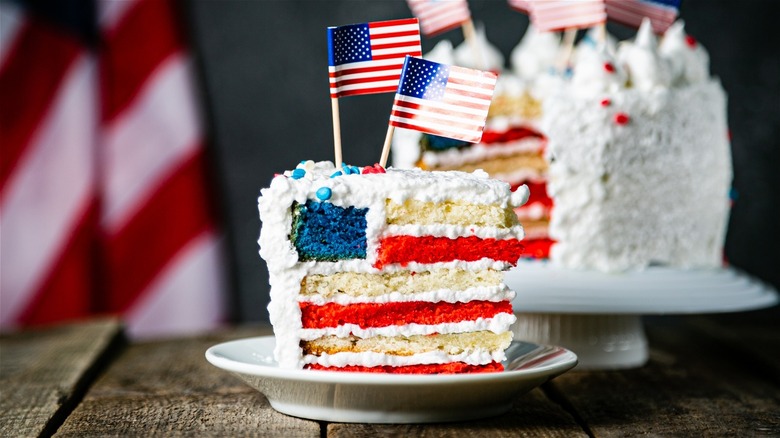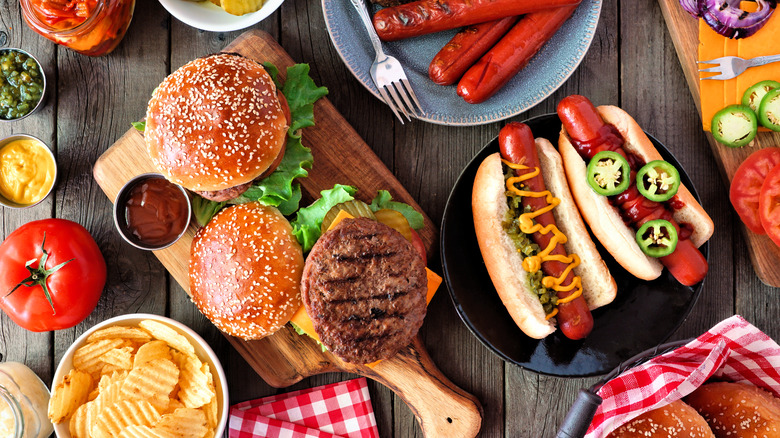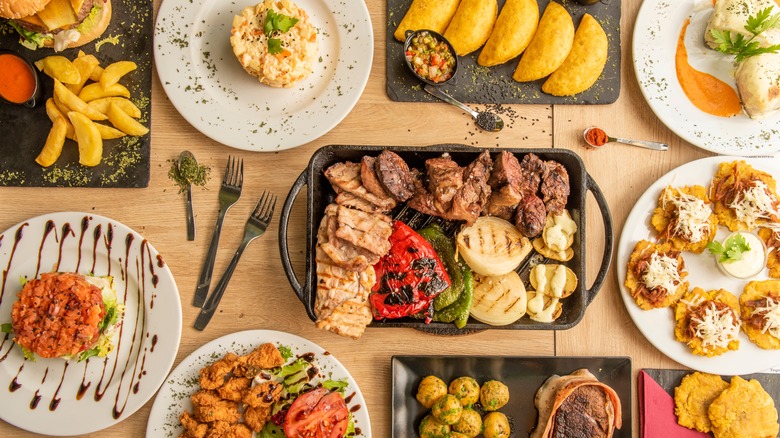Why It's So Hard To Describe American Food
It has gotten tricky trying to put things neatly into a box with a label, despite Marie Kondo's best efforts. Over the past decade, an attempt at labeling another's sexuality, gender, or nationality is less about how you perceive them but rather a profoundly subjective answer. A person may describe themself as American when traveling abroad but Italian-American stateside. One label doesn't capture it all. The same is true for cuisine.
To simplify things, we blanket all cuisine from Italy as Italian food, despite the country containing 20 regions. Each regional cuisine is nuanced, influenced by its climate, terrain, and neighboring countries, and has contributed individually to one of the most popular cuisines in the world. In the Lombardy region, the northern region bordering Switzerland, polenta is actually more popular than red-sauce-covered pasta, which is more of a Lazio region delicacy where Rome is located. It's a similar situation for Chinese cuisine. The country has eight regions; Shandong, Sichuan, Hunan, Guangdong (Cantonese), Zhejiang, Jiangsu, Anhui, and Fujian. Each region varies from how they plate their food to how spicy they prefer it, and labeling it all as Chinese is an oversimplification.
Perhaps it is more so in America, a newer nation built by immigrants who brought the recipes from their homelands to make a home here. Chefs and food writers have tried to label American cuisine but fall short of capturing the essence of the food fused with cuisines worldwide, leaving everyone to question what American food is.
It's not just hamburgers and hot dogs
The U.S., like other nations, is broken into geographical regions outlined by mountains or rivers, influencing the cuisine. Foreigners may associate apple pie, hamburgers, and hot dogs with "American" food, but the cuisine is much more diverse than those Fourth of July favorites. Depending on who you ask, the U.S. comprises seven regions; New England, Mid-Atlantic, the South, Midwest, Rocky Mountains, the Southwest, and the Pacific coast.
With such a large territory and diverse landscape sandwiched between two oceans, several mountain chains, and even a desert, our crops vary as much as the people in each region. The Northeast is known for its Maine lobsters, seafood chowders, and New York bagels. In contrast, Southern cuisine can be summed up with cornbread, sweet tea, and barbecue. However, in pockets of every region, chefs are creating fusion cuisine combining grilled lobster tails with miso butter or Mexican-flavored Texas barbecue that's becoming as American as the original.
Since the 1980s, chefs have tried on the label "New American cuisine," which came out of California. Chef Jeremiah Tower explained in his book, "New American Classics," that while working at Alice Waters' Chez Panisse in the' 70s, they began a fusion cuisine he explained as "American food using French cooking principles," using locally sourced ingredients (per LA Times). Wolfgang Puck was at the forefront of this movement too. The Austrian chef-to-the-celebrities combined a very Californian chopped salad with Chinese ingredients to create his famous "Chinois salad."
New American cuisine
New American cuisine takes "American" dishes like ribeye steak and borrows techniques and "exotic" ingredients from other cuisines to make something unique; sake-marinated rib eye steak with spicy chili crisp or even the cronut. New York Times food critic William Grimes sums up New American cuisine in a 1999 review of Larry Forgione's restaurant, An American Place, saying, "Spring rolls are indisputably Asian, but when they're stuffed with Dungeness crab from Washington State and served with a smoked onion remoulade and Charleston vegetable slaw, it's pretty clear that the culinary melting pot has absorbed yet another immigrant." To define the cuisine better, chefs are spelling out where the ingredients are sourced in the dish's lengthy descriptions like a "culinary green card."
American food as a title is vague and vast, with endless possibilities. As cooks, our ability to combine cultures into a dish grows exponentially as shopping for unfamiliar "exotic" ingredients becomes easier. The internet and cooking shows have provided more dinner inspiration beyond our zip codes. While it makes it challenging to describe a restaurant or a dish when it doesn't fit into a neat box, the food can be infinitely more interesting. America is a melting pot, and its cuisine should represent that.


